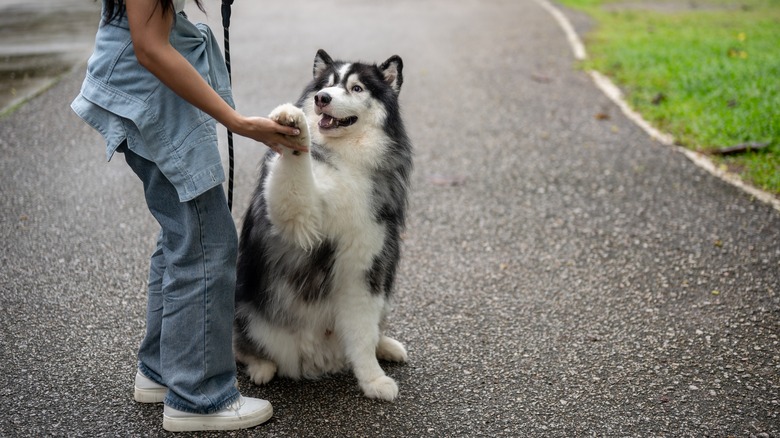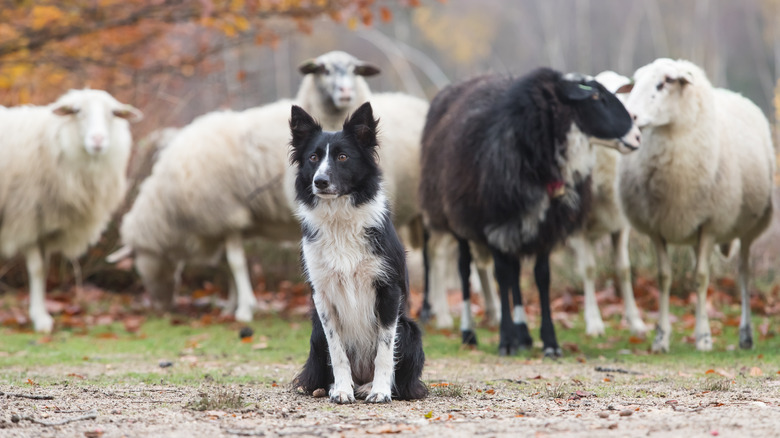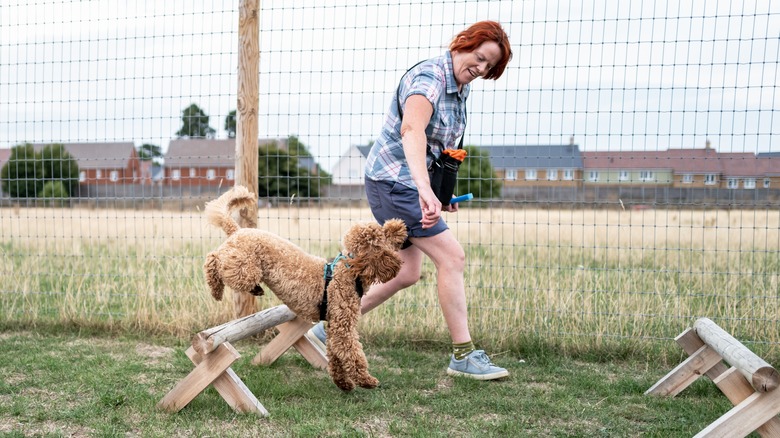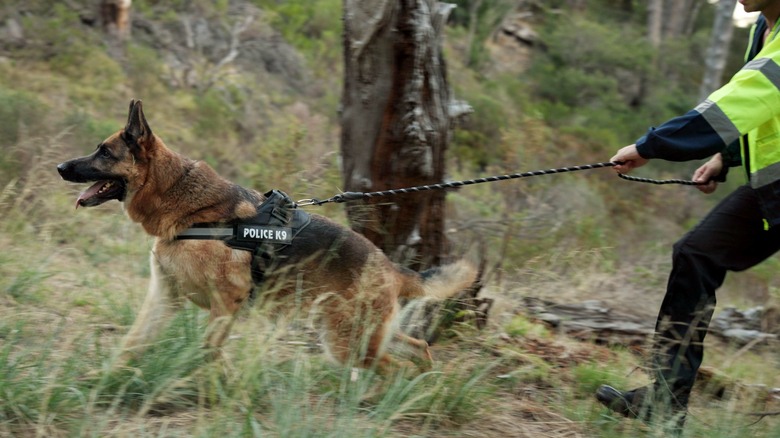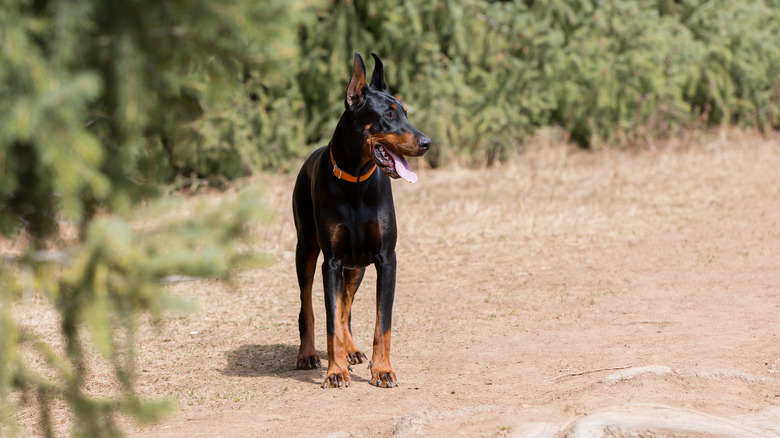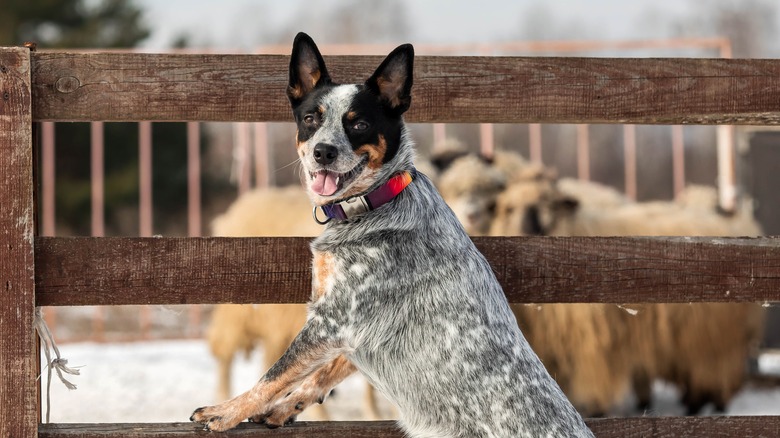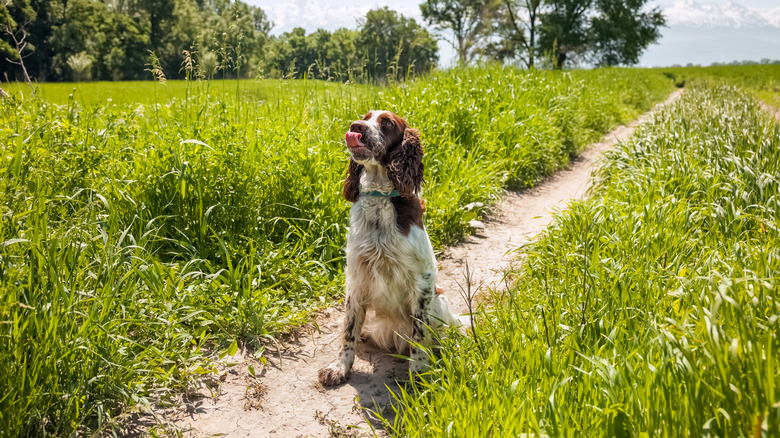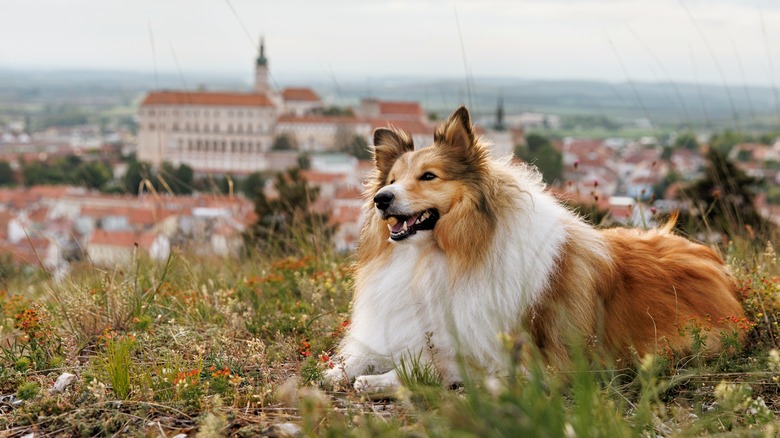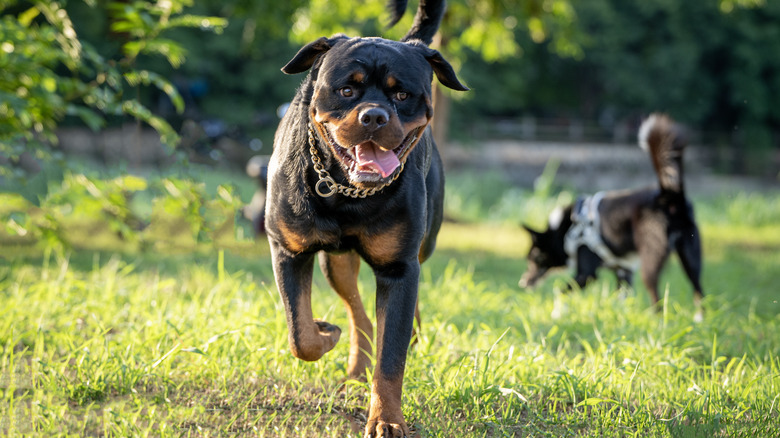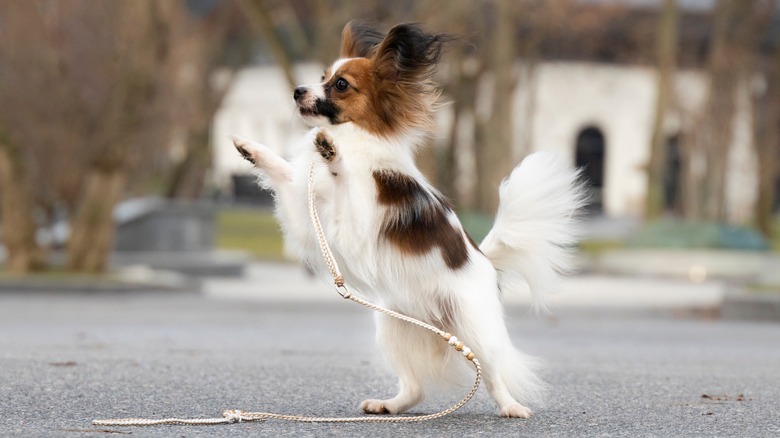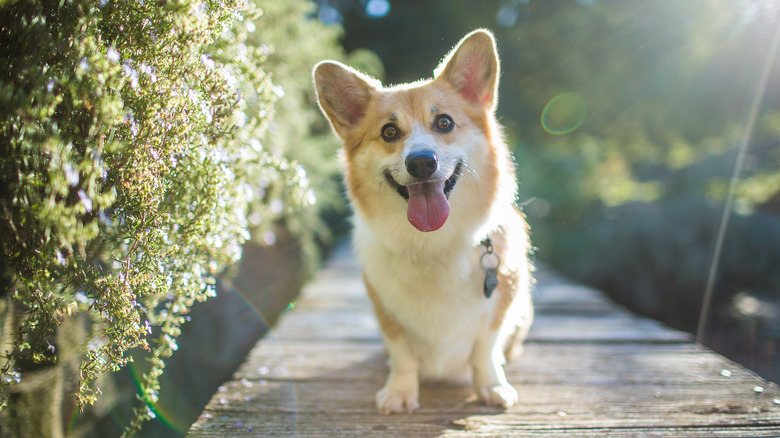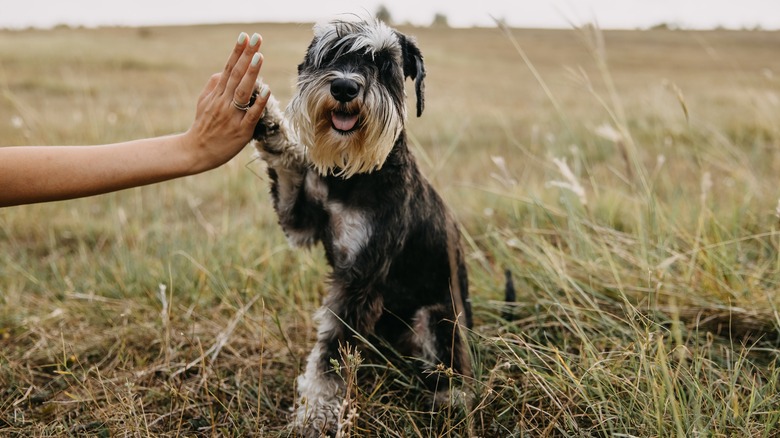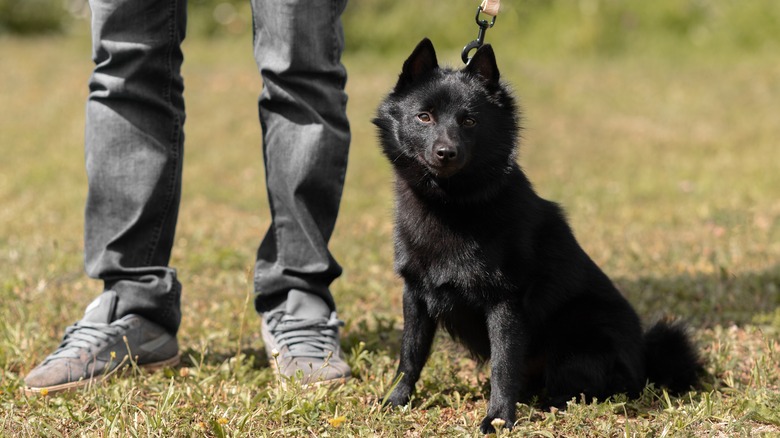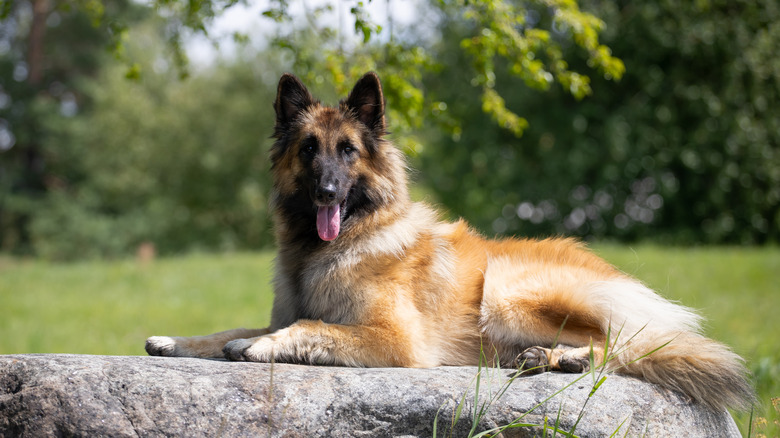The Smartest Dog Breeds In The World
We may receive a commission on purchases made from links.
You might think your pup is the smartest of them all, but that largely depends on their breed. At the American Psychological Association's 117th Annual Convention, Dr. Stanley Coren, a top canine researcher and psychology professor, explained, "There are three types of dog intelligence: instinctive (what the dog is bred to do), adaptive (how well the dog learns from its environment to solve problems) and working and obedience (the equivalent of 'school learning')." Therefore, a canine's intelligence can be measured using these criteria, much like humans who take an IQ test.
Based on his findings, Coren believes that the average dog has the mental intelligence of a 2-year-old child and can learn 165 words. However, the most intelligent breeds have a mental intelligence of a slightly older child and can typically learn 250 words. Coren has ranked the top five brightest dog breeds as border collies, poodles, German shepherds, golden retrievers, and Doberman pinschers. (You can find Coren's intelligence ranking of over 100 dog breeds in his book, "The Intelligence of Dogs.") However, the list of sharp canine breeds extends well beyond the researcher's prime picks. Just what makes these dogs rank so high?
Border collie
The border collie took the No. 1 spot on Coren's ranking of intelligence. Border collies hold the title of "smartest dog breed in the world" because they can learn new words and commands quickly, often within five repetitions. One border collie named Chaser was able to remember 1,022 different names for her toys, which were taught to her over a span of three years. She pushed past the intellectual expectations of her breed with the help of her caregiver, John W. Pilley, who saw potential in her. Pilley worked as a psychology professor interested in animal behavior and viewed Chaser as a scientific opportunity. He devoted much of his time to teaching her skills and published his research in 2011 in the Behavioural Processes journal.
Border collies are workaholics by nature and excel in herding, obedience, and agility activities. They're excellent pets for active people, as they need a minimum of one hour of exercise every day. Because border collies are natural herders, they might herd other pets and family members when they feel anxious or have too much pent-up energy. They may even nip at them to get them in line as they would do when herding sheep.
Poodle
The wavy coats of poodles allow for many different grooming cuts that usually incorporate pom poms and puffs, making them one of the most stylish and smart dog breeds. Poodles come in three types, which differ by height. At the shoulder, standard poodles are 22-27 inches tall, miniature poodles are 13-15 inches, and toy poodles are 10 inches or fewer. Personality and energy also vary between the varieties, but all have more allergy-friendly coats and possess great intelligence.
Because of their mental capacity, poodles need advanced training to prevent boredom, which can lead to destructive behaviors. This breeds desire to please their caretakers motivates them to learn new tricks quickly. They also enjoy figuring out puzzles and challenges. Poodles were bred and used as hunting dogs and thus are high-energy and require a lot of exercise. Additionally, they excel at swimming and agility. Due to their trainability and performance skills, they have featured in a number of circus shows.
German shepherd
German shepherds are muscular, medium to large dogs with a height of 22-26 inches. They have long, straight coats and a wolf-like look. Because they were originally bred for herding, they thrive when put to work or engaging in some type of activity with their caregivers. Thanks to their high endurance, they can keep going for hours; as a result, active families do best with this breed. They are strong-willed and can be a bit nervous in unfamiliar situations, making early training and socialization a must. However, even nervous German shepherds won't let that get in the way of defending the people they care about when in danger.
German shepherds are well-rounded dogs who love having a purpose. They perform well in the police force, search and rescue missions, as emotional support animals, and as family companions. The quick manner in which German shepherds apply what they've learned highlights their intelligence. Their adaptability, loyalty, obedience, and alertness are just some of the other factors that make this breed so desirable.
Golden retriever
Friendly and affectionate, golden retrievers are one of the best types of canines for children to grow up with. According to the American Kennel Club (AKC), they were the third most popular dog breed in the United States in 2023. Dr. Stanley Coren has also identified them as the fourth most intelligent breed.
Golden retrievers are medium-sized canines with a height of 21-24 inches. Not all dogs love to swim, but this breed does. Their thick, water-repellent double coats helps them swim far distances with ease. They can live on farms and in apartments as long as they're taken outside for walks and playtime daily. These pups seem to have it all.
Golden retrievers come across as big goofballs: They eat items they shouldn't, are prone to silliness, and play like kids. But they're smarter than many people realize. Although they can get up to mischief, golden retrievers do well in obedience training and only need to be told something a few times to understand the command. They also excel in tracking, retrieving, hunting, and agility.
Doberman pinscher
Lean working dogs, Doberman pinschers can get up to 28 inches tall. Although they have short coats, they shed heavily, making daily brushing an ideal strategy. Thanks to the Dobermans' high prey drive, pet parents need to be cautious about letting their dogs off the leash in unfenced areas. Further, this breed likely won't be able to resist going after birds and rabbits without extensive training, so small pets should never be left to walk freely around them. Many people believe different types of Doberman pinschers exist, but the AKC doesn't recognize any others.
In addition to being muscular and protective, the high intelligence of Doberman pinschers got them into the war dogs program in World War II. They're also utilized as therapy dogs and in search and rescue missions for similar reasons. Dobermans possess the impressive intuition and can sense threats. But they're not all serious; they are also loving to their caretakers and try to make them laugh.
Australian cattle dog
Australian cattle dogs are full of energy and need abundant mental and physical exercise to live a fulfilled life. Because of their need to keep moving, natural instincts, and incredible endurance, they make excellent cattle herders. However, these instincts often carry through to home life, and they may try to herd children and pets. Caretakers will need to train them out of this behavior, especially if it involves nipping. These sweet dogs are a very loyal breed, and once they've bonded with someone, they'll want to spend as much time with them as possible.
Like the border collie, Australian cattle dogs enjoy challenges. In fact, they're excellent problem solvers, adaptable, easy to train, and rely heavily on their instinctual intelligence, especially when it comes to their favorite job of herding. They can also learn from past experiences and adapt their approach to get a different outcome. Additionally, these dogs are hyper-aware of their caregiver's moods, pointing to a level of emotional intelligence.
English springer spaniel
A medium breed, English springer spaniels can get up to 20 inches tall. They have long, floppy ears and a double coat with many color varieties. Bred for bird hunting and retrieving, they are easy to train, alert, and eager to please their caregivers. They also make wonderful companions and have an affectionate and social personality. As attention lovers, they will act up if they don't get enough of your time. Further, they may struggle if left alone for long periods and develop separation anxiety.
English springer spaniels enjoy training, pick up commands quickly, are obedient, and do well in dog competitions and sports. For maximum happiness, they need to stay physically and mentally active. They love being outdoors or working out the solution to a problem. You can keep these dogs busy with hide-and-seek, scent trail tracking, and water retrieval. Alternatively, try one of the many different types of puzzle toys to keep your dog mentally stimulated.
Shetland sheepdog
Shetland sheepdogs combine brains with beauty. They have heavy coats and long snouts but are quite small in size, with a height of up to 16 inches. However, this is a bigger than how the breed used to be, as it once only reached a height of 10 inches from the shoulder. The lifespan of a Sheltie (the nickname for a Shetland sheepdog) is 12-14 years. Although small, these dogs are protective. They were bred to look after sheep but are now great guard dogs who are very vocal and enjoy barking to get attention and alert their family to concerns. They make loving companions who enjoy being in the company of those they care about, even if that means following them around the house.
Shelties are perceptive and emotionally intelligent. They're also hard workers who excel at herding, whether that is sheep or the humans they live with. They enjoy learning new words, tricks, and tasks and pick them up easily, along with performing well in agility sports. Due to their trainability and gentle natures, many Shetland sheepdogs work as service or therapy animals.
Rottweiler
These pups protect and defend their family members, making them excellent guard dogs. Yet, they're also loveable clowns who develop strong bonds with their people. While good around young and older children, Rottweilers tend to bump them over because of their solid build, making supervision a must at all times. Depending on their personality, a Rottweiler may show affection amongst their family members or prefer to stick to one person. While they may dole out this affection in various ways, the breed likes leaning against people as an expression of trust and love.
It's important to start training Rottweilers when they are still young to avoid territorial issues. Once trained, they can be guided and controlled verbally. Although they have large bodies and can reach up to 27 inches tall, they are gentle at heart and very obedient. Due to their sharp minds, adaptability, and eagerness to work, Rottweilers serve as therapy animals, police dogs, customs inspectors, and obedience competitors, among other roles.
Papillon
Papillons are one of the smartest and oldest toy dog breeds in the world, with evidence of their existence dating all the way back to the 16th century. These pups can reach a height of 8-11 inches and weigh up to 10 pounds, but they're quite active and need at least 30 minutes of exercise daily . You can accomplish this in your home by playing fetch or tug-of-war without worrying about a big body bumping your lampstands and chairs over. Further, papillons enjoy walks, obedience training, and agility sports, often securing championships in dog competitions. They stand out in a crowd because of their silky coats and long, outstretched ears, which look like butterfly wings.
Although smart and highly trainable, papillons may struggle to master potty training quickly, but they get there with patience and consistency from their caregivers. In need of mental and physical stimulation, papillons like mastering new tricks because they challenge their minds. Due to their social nature, they may struggle during time away from their humans, so pet parents should look into products that help ease separation anxiety in dogs.
Pembroke Welsh corgi
Pembroke Welsh corgis are short dogs with big personalities. Although low set, they make excellent sheep and cattle herders and don't let the larger sizes of these animals intimidate them. Although not widely used for herding today, they still have the opportunity to show off their instincts and compete in a few different clubs, such as the American Kennel Club, American Herding Breed Association, and Australian Shepherd Club of America, where they have won championship titles. However, their sporting abilities extend beyond this sphere, as they also perform well in tracking, rallying, obedience, and agility.
Though strong-willed, independent thinkers, Pembroke Welsh corgis respond to positive reinforcement and are highly trainable. They're also sensitive and emotionally intelligent. Despite their size, these dogs have a lot of energy to burn off and need at least an hour of daily exercise, making them a better option for active families.
Miniature schnauzer
Miniature schnauzers are working dogs who can pick up new commands quickly, typically between five to 15 repetitions. They're also highly obedient and usually respond to the first command at least 85% of the time, per Dr. Stanley Coren. Although three types of schnauzers exist, the miniature version typically possesses the greatest intelligence. Meanwhile, the giant schnauzer (also a smart dog) tends to have the lowest intelligence of the trio. Great at problem-solving, the miniature schnauzer applies what they've learned to avoid repeating an action that didn't work out in the past. Additionally, they are obedient and quick thinkers.
Miniature schnauzers reach 12-14 inches tall and between 11-20 pounds. They have bushy eyebrows, a beard, and a wiry coat that doesn't shed much but needs a trim every two months. These dogs do well in various housing types, such as apartments or farms, but they need a lot of attention and don't like being left alone for long. Although small, they're good watchdogs who will bark at sounds, people, or signs of danger. With their background in rat chasing, they're also quick to chase small pets, leaves, or insects.
Schipperke
If you're not as familiar with the schipperke breed, it's because they're not common in America, with the AKC giving them a popularity ranking of 113 based on its registration statistics in 2023. They possess a foxlike appearance, with a dense black coat, dark eyes, pointy ears, and a fluffy tail. Though they only reach a height of around 13 inches, these dogs are highly active, curious, and aware of everything happening around them. Affectionate and loyal, they love children and make great family dogs despite their independent nature.
Schipperkes are typically outgoing, enjoying exercise and activities with their humans. Thanks to their athletic abilities, they tend to do well in most sporting activities. However, due to their high prey drive, they don't do well off-leash, making it important for them to live in fenced-in homes. Although intelligent, these independent thinkers tend to rely on their instincts over the commands of their caregivers unless properly trained. Schipperkes like training for the mental stimulation it provides, along with brain puzzles, which can help keep them busy.
Belgian Tervuren
A medium-sized dog, the Belgian Tervuren grows to a height of 22-26 inches. They have double coats that don't need to be brushed more than once a week, but it may take you close to 30 minutes to get through all of it. These wonderful pets do best with experienced dog parents due to their high energy needs and intelligent minds. Belgian Tervurens can outsmart their caretakers and develop undesirable behaviors if left alone to the point of boredom, so early socialization and obedience training are a crucial, as well as daily mental and physical exercises. When raised well, these dogs are highly responsive to their caregivers, who they very much want to please.
Belgian Tervurens are loyal and have plenty of stamina. They love to work and are used for many jobs. However, they also perform well as companion dogs, are devoted to their humans, and like to join in on activities like hiking. They were first used to herd sheep, so they have a naturally high prey drive and chase smaller people and pets; thus, they tend to be better suited to households without kids. Due to their bravery, trainability, and natural intuition, Belgian Tervurens add great value to search and rescue missions, protection efforts, and other tasks required of military dogs.
